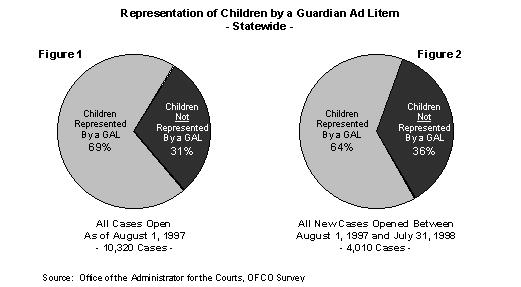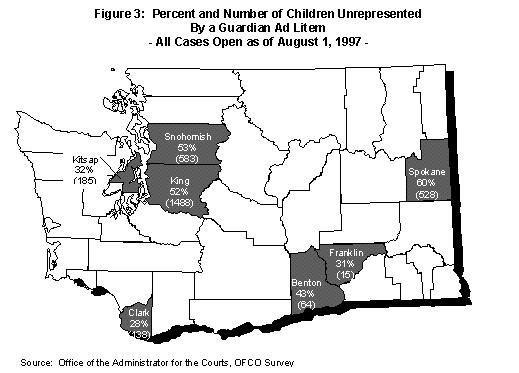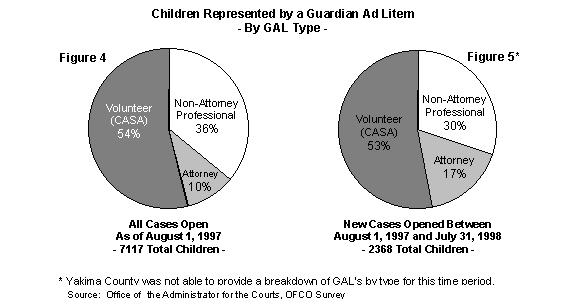

 |
 |
FINDINGS AND CONCLUSIONS
The results of OFCO’s investigation reveal that approximately one-third of Washington children who are involved in child abuse and neglect proceedings do not have a guardian ad litem to represent their best interests. These children are concentrated in seven counties. Moreover, information obtained during the course of the investigation indicates that children in three counties are served by professional GALs with extremely high caseloads.
Children Not Represented by a GAL
Figure 1 portrays GAL representation in all child abuse and neglect cases that were ongoing as of August 1, 1997. Thirty-one percent of these cases (3,203 children) were without the services of a GAL.

Figure 2 portrays only those new cases that were opened within the year between August 1, 1997 and July 31, 1998. Of these new cases, 36 percent (1,449 children) were without the services of a GAL. Therefore, whether considering ongoing or recently opened cases, a significant percentage of children in child abuse and neglect proceedings did not have a GAL.1
Counties of Concern
Seven Washington counties account for nearly all of the children who do not have a GAL (See Figure 3). At least 15 percent of the children in these counties had no GAL representation in either time period surveyed by OFCO. In all ongoing cases surveyed as of August 1, 1997, more than 25 percent of the children in these counties had no GAL representation. Nine other counties reported no more than 13 percent of children unrepresented in either time period surveyed.2

County Policies and Practices Affecting GAL Appointments
The following describes county policies and practices that affect GAL appointment:
Type-C Dependencies
Two of the seven counties, Clark and King, use dependency type to justify not appointing a GAL for good cause. In these counties, no GAL is appointed to represent children in what are known as Type-C dependencies. In Type-C matters, there are no allegations of abandonment (Type-A) or abuse or neglect (Type-B). Rather, it is alleged that the child has no parent capable of adequately providing care (for other reasons, such as the parent’s developmental limitations, medical condition, mental illness, parenting behavior, etc.).
Other Good Cause Factors
In King County, children may also be denied a GAL for good cause according to formal guidelines set by the court. An allegedly abandoned, abused or neglected child in King County is referred to the GAL program for a possible appointment based on four broad factors: (1) child’s current placement, (2) parental contact with the child, (3) child safety risk factors, and (4) the child’s special needs.3 It is considered good cause not to appoint a GAL for children who do not meet certain criteria.
Periodic Review GALs
Prior to the Fall of 1998, children in Spokane County were appointed a "periodic review GAL." These GALs did nothing more than attend semi-annual review hearings concerning a child’s case. They did not investigate the child’s circumstances, or perform any duties other than attend hearings. Thus, although these children technically had been appointed a GAL to represent them, that individual was precluded from performing the essential function of a GAL: obtaining first-hand, a clear understanding of the child’s situations or needs. Accordingly, these children are included in the total number of unrepresented children. Since the completion of OFCO’s investigation, Spokane County has drafted new rules for determining good cause not to appoint.4
Independent Counsel
The policy in Benton and Franklin Counties is to appoint independent counsel to represent children nine years old or older, and a CASA volunteer to represent the younger children. If a petition for the termination of parental rights (TPR) is filed, the policy is to appoint independent counsel regardless of the child’s age. In King and Kitsap Counties, a similar policy exists except that the age break is 12 or older.
Unavailable GALs
In Snohomish County, each new case is given by the court to the CASA program, and a CASA volunteer is appointed, if one is available. No finding of good cause is made to justify the decision not to appoint a GAL. If a CASA volunteer is unavailable, the child proceeds through the system without representation unless a petition for termination of parental rights is filed, in which case a GAL is appointed and paid if necessary.(shaded table here)
Types of GAL Representation
Most children who were represented by a GAL were represented by a CASA volunteer, as opposed to a professional GAL or an attorney GAL. As shown in Figure 4, fifty-four percent of all children represented by a GAL (3,835 children) were represented by a CASA volunteer. Thirty-six percent (2,555 children) were represented by professionals, and 10 percent (727 children) were represented by attorneys. Figure 5 shows a similar percentage of CASA volunteers as GALs, 53 percent (1,249 children), for new cases opened between August 1, 1997 and July 31, 1998. In these new cases professionals represented 30 percent of the children (713 children), and attorneys represented 17 percent (406 children). Thus, in both time periods, CASA volunteers provided the majority of GAL services to children.

Caseload Issues
Information obtained during OFCO’s survey of county officials indicates that children in three counties are being served by professional GALs with extremely high caseloads. In Pierce County, each professional GAL represents on average about 140 children at one time, while Spokane County reports that at least one professional GAL has a caseload of about 90 children. Yakima County reports that the single, full-time professional GAL represents about 400 children, while a half-time professional GAL represents about 150 children. The concern over high caseloads in these counties was reinforced in comments by the superior court judges and commissioners contacted by OFCO as part of its investigation. (shaded table 2 here)
Analysis/Conclusions
Washington State’s compliance with CAPTA funding requirements is problematic. CAPTA requires that every child who is involved in a child abuse and neglect proceeding have a GAL appointed to represent his or her best interests. However, one-third of such children in Washington State do not have a GAL to represent their best interests. It is the undisputed practice in several counties not to appoint GALs in certain situations, or for some children. In at least one county, if a child’s case is filed at a time when a CASA volunteer is unavailable, the child is simply left to proceed through the dependency process without a GAL. In other counties, children who do not meet formal or informal criteria are not appointed a GAL. These practices appear to be a response to the insufficient numbers of GALs that are available for appointment.5
Washington’s statutory good cause exception does not appear to authorize these practices. This exception allows courts to decide not to appoint a GAL if they find for "good cause" that the appointment is "unnecessary." However, the Washington Court of Appeals has made clear that the practice of failing to appoint a GAL, or finding good cause not to appoint a GAL based on lack of resources, is a violation of the state’s mandate to appoint.6 Moreover, because the exception authorizes courts not to appoint a GAL in certain instances, the good cause exception appears to violate CAPTA’s universal mandate to appoint in all instances. If in conflict with CAPTA’s funding requirements, the good cause exception is, according to Washington law, inoperative.7
Children in child abuse and neglect proceedings suffer when they do not have advocates for their best interests. Research clearly indicates that in cases where children are not represented by a GAL, the cases take longer to resolve, and the children themselves are likely to spend significantly more time in substitute care, compared to cases in which children are represented by a GAL.8
Finally, the extremely high GAL caseloads reported in Pierce, Spokane, and Yakima counties are of concern. High caseloads necessarily limit the amount of time that a GAL can devote to each case. In contrast to the reported caseloads of these professional GALs, which range from 90 to 400 children per GAL, each CASA volunteer is responsible for anywhere from one to 15 children, with the county averages running from 1.7 to 4.5 children per volunteer.9 Not surprisingly, CASA volunteers spend far more time on cases than professional GALs.10
The amount of time that a GAL is able to expend on a child’s case is important. CAPTA states that GALs are "to obtain first-hand, a clear understanding of the situation and needs of the child." This usually requires thorough investigation. Moreover, community professionals agree that the most effective vehicle for identifying, advocating for, and representing the child’s best interests is thorough investigation of the child’s circumstances.11 Thorough investigation often requires a significant investment of time.